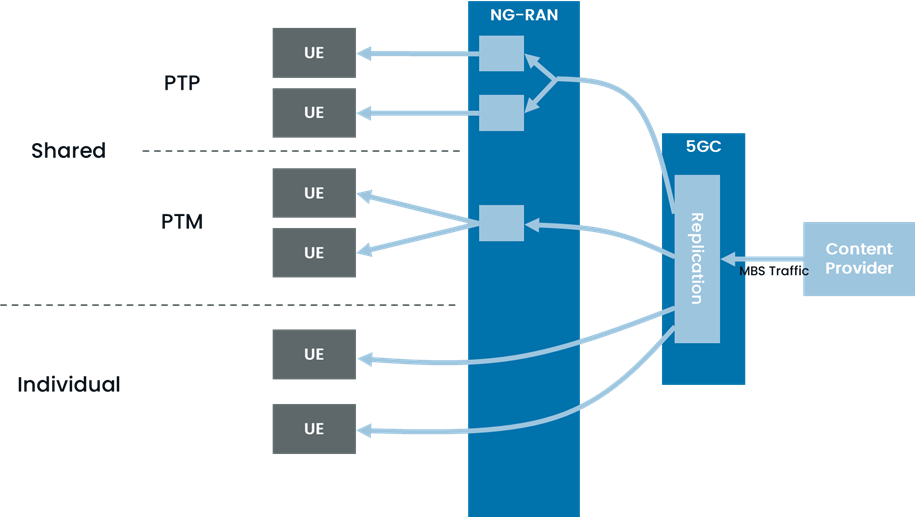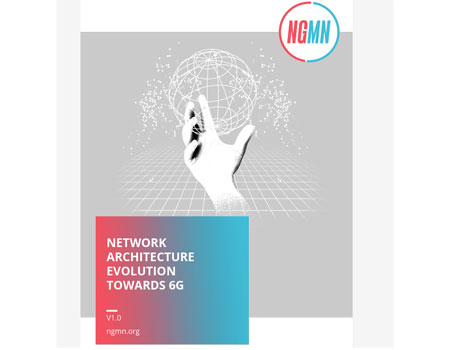By Dongwook Kim, 3GPP MCC
This article provides an overview of the broadcast/multicast technology specified by 3GPP, with the focus on 5G support.
Why Broadcast/Multicast?
The broadcasting industry has been facing a demand shift towards streaming and on-demand multimedia consumption, creating the need for them to transform broadcast networks to new enhanced platforms. The increased demand for multimedia content over mobile devices has in turn grown the level of traffic over networks, driving the need for network expansion to cater to the demand.
This demand is leading to a fundamentally different approach to processing such services. The broadcast/multicast technology offered by 3GPP standards brings multiple benefits:
- Services can be provided over the existing infrastructure and spectrum, often requiring only incremental adjustments to deployed mobile network.
- 3GPP broadcast/multicast technology can offload different types of traffic from unicast. For example, streaming of identical or live content. Considering that the multimedia services, especially video, occupies much of the bandwidth, this functionality can enhance network efficiency.
- 3GPP broadcast/multicast technology provides scalability of broadcasting services, with large numbers of users or UEs able to access content.
As well as the broadcast industry, other sectors also benefit from the 3GPP broadcast/multicast, notably Public safety communications – by pushing data communications out to designated destinations.
Another promising use case is vehicle to everything (V2X), where broadcast can push messages or alarms - over an Intelligent Transportation System (ITS) - to infrastructure, vehicles and to and the devices within.
What is Broadcast/Multicast?
3GPP has been supporting broadcast/multicast technology since the days of 3G (more specifically, UMTS: Universal Mobile Telecommunications Service). Multimedia Broadcast/Multicast Service (MBMS) architecture and protocols were defined to support broadcast/multicast use cases with 2G and 3G networks. However, the service did not achieve great success due to low media consumption using mobile devices at the time.
With 4G Evolved Packet System (EPS), the MBMS system was enhanced to leverage the strengths of LTE, such as Orthogonal Frequency Division Multiplexing (OFDM) and Carrier Aggregation (CA), and the relevant work has been progressing from Release 9 through Release 16. To distinguish with the MBMS of UMTS, the enhanced MBMS leveraging 4G networks is called eMBMS (evolved MBMS) or FeMBMS (Further evolved MBMS) depending on the release (14 or later for the latter). There have been some commercial deployments of eMBMS around the world.
For 5G networks, 3GPP already defined in its Release 15 requirements that the broadcast/multicast services need to be supported. While there have been some descriptions in New Radio (NR) and 5G Core (5GC) specifications to satisfy this requirement, it was in Release 17 when 3GPP specified architectural enhancements to the 5G System (5GS) using NR to support multicast and broadcast services. This architectural enhancement is referred to as Multicast and Broadcast Service (MBS).
The history above indicates the broadcast/multicast supported by 3GPP requires extensive description of the relevant systems across three generations. However, considering the objective of overviewing relevant aspects of 5G technology and the limited space, this document/page will focus on broadcast/multicast aspects of the 5GS and only briefly describe MBMS (3G) and eMBMS/FeMBMS (4G).
MBMS
In UMTS, MBMS was devised to offer both broadcast and multicast service over the 3G network. The MBMS required changes in the Packet Switched (PS) domain entities in the UMTS - Gateway GPRS Service Node (GGSN), Serving GPRS Service Node (SGSN), UMTS Terrestrial Radio Access Network (UTRAN), GSM EDGE Radio Access Network (GERAN), User Equipment (UE) - and an addition of a new functional entity called Broadcast-Multicast Service Centre (BM-SC). The BM-SC processes MBMS specific activities (e.g., authorising UEs that request MBMS service, managing MBMS sessions, and interworking MBMS services of different network operators in roaming scenarios). While MBMS has not been a great commercial success, the MBMS nevertheless provided the foundation for addressing broadcast/multicast services with 3GPP networks.
eMBMS and FeMBMS
In EPS, MBMS was enhanced to eMBMS and further to FeMBMS. The architecture of eMBMS (and FeMBMS) different from MBMS in that there are more entities than BM-SC to support eMBMS, as shown in Figure 1. Namely, Multi-cell/multicast Coordination Entity (MCE) and MBMS Gateway (MBMS-GW). MCE serves one or more eNodeBs (eNBs), allocates radio resources used for MBMS transmissions, and is involved in the signalling of MBMS session control. MBMS-GW sends/broadcasts MBMS packets to the eNBs that are transmitting the broadcast/multicast service, and it controls the MBMS sessions in the evolved UTRAN (E-UTRAN) via Mobility Management Entity (MME). Therefore, unlike MBMS, more granular control of the Radio Access Network (RAN) entities is possible with these new eMBMS entities.

Figure 1 eMBMS architecture (3GPP TS 23.246 v14.2.0 and 3GPP TS 36.300 v14.9.0)
In addition, eMBMS introduced the concept of MBMS Single Frequency Network (MBSFN) to deliver the broadcast/multicast service. MBSFN is a transmission technique where identical waveforms are transmitted at the same time via a group of cells covering a geographic area. Alternatively from Release 13, Single Cell Point to Multipoint (SC-PTM) can be used to adjust the broadcast/multicast area with the granularity of a single cell and to dynamically use radio resources of each cell.
eMBMS also offered major enhancements compared to MBMS. For example, the eMBMS enhanced service continuity by specifying relevant signalling and mechanisms in both single and multi-frequency scenarios. New features such as MBMS operation on demand was specified, which enables the operator to move multiple unicast services into one broadcast service given a certain threshold, rather than waiting for explicit eMBMS session start by the operator and UEs' request.
In Release 14, more features were introduced to enhance eMBMS and the eMBMS since Release 14 is usually referred to as FeMBMS in the industry. For example, using longer cyclic prefix in specific scenarios was considered and specified. xMB interface was also defined such that the content providers can access BM-SC. Using this interface, the content provider can invoke procedures to setup and manage MBMS user service from BM-SC to the MBMS clients, while the BM-SC can use this interface to authenticate/authorise a content provider, retrieve contents from the content provider, and notify the content provider of the status of MBMS service usage. Furthermore, in FeMBMS, the architecture was enhanced to support the requirements of TV services to be carried over E-UTRAN.
MBS
To address broadcast/multicast requirements with 5G, different architecture had to be adopted given that NR came with characteristics from those of LTE (e.g., beamforming, non-SFN deployments, etc.). Therefore the MBS architecture was defined as shown in Figure 2.

Figure 2 MBS architecture (3GPP TS 23.247 v17.4.0)
As can be seen, the MBS related entities are within the 5GC and there are four entities that need to be deployed to support MBS:
- Multicast/Broadcast Session Management Function (MB-SMF): manages MBS sessions and interacts with the RAN and MB-UPF for data transport
- Multicast/Broadcast User Plane Function (MB-UPF): enforces QoS and delivers multicast and broadcast to UPF or RAN nodes
- Multicast/Broadcast Service Function (MBSF): provides service level functionality for MBS, including interaction with Application Function (AF) and MB-SMF for MBS sessions.
- Multicast/Broadcast Service Transport Function (MBSTF): provides generic packet transport functionalities and serves as media anchor for MBS data traffic.
An important consideration in defining MBS architecture is the support of MBS services in the legacy (Release 15 and 16) 5G nodes. Therefore, two delivery methods were defined to support MBS. First is the 5GC shared MBS traffic delivery method, where 5GC receives a single copy of MBS data packets and delivers a single copy of those MBS packets to an Next Generation RAN (NG-RAN) node, this is then delivered to one or multiple UEs. The second is 5GC Individual MBS traffic delivery method, only applicable to multicast. This is where a single copy of MBS data packets received by 5GC is delivered as separate copies each to be delivered to an individual UEs via pe-UE Packet Data Unit (PDU) sessions. The difference is outlined in Figure 3. Note that the NG-RAN decides whether to transmit the MBS data packets in Point-to-Point (PTP) delivery method or Point-to-Multipoint (PTM) delivery method. Where the former delivers separate copies of MBS data packets over radio interface to each individual UE while the latter delivers a single copy of MBS data packets over radio interface to multiple UEs.

Figure 3 Delivery methods for MBS (3GPP TS 23.247 v17.4.0)
To provide multicast/broadcast service, the MBS service is broken down into different phases (also summarised in Figure 4).
- MBS session creation: The AF provides information necessary to create MBS session towards 5GC. Optional for multicast.
- Service announcement: distribute information toward UEs about the service required for service reception. Optional for multicast.
- (Multicast only) Session establishment: The multicast MBS session is established with the joining of the first UE.
- For multicast, the UE may join or leave the session via UE Session Join/Leave phases.
- (Multicast only) No data receiving: No data is received by 5GC. Optional for multicast.
- Data transfer: Multicast/broadcast data are transferred to the UEs
- (Multicast only) Session release: The multicast MBS session is released with the last UE leaving.
- For multicast, the UE may join or leave the session via UE Session Join/Leave phases.
- (Multicast only) Session deletion: The multicast MBS session is deleted, with all information related to the session being removed from 5GC.
- (Broadcast only) Session release & deletion: The resources for the broadcast MBS session in 5GS are released and the broadcast MBS session is deleted.

Figure 4 Data provisioning phases for MBS services (3GPP TS 23.247 v17.4.0)
To aid in the understanding of the readers, the following figures show multicast service timeline example (Figure 5) and broadcast service timeline example(Figure 6). They comprise of different phases in different times that could occur in real-life MBS service.

Figure 5 Multicast service timeline example (3GPP TS 23.247 v17.4.0)

Figure 6 Broadcast service timeline example (3GPP TS 23.247 v17.4.0)
Release 15 and 16 functionalities
In Release 15 and Release 16, the general requirements for the 5G system to address broadcasting services were studied and specified (e.g., 3GPP TS 22.261). Furthermore, there were enhancements to eMBMS (for 4G) that were studied and specified. For example, leveraging HTTP (Hypertext Transfer Protocol) Live Streaming (HLS) technology and using MBMS for mission critical communications. This was also when the MBMS technology was enhanced to meet the IMT-2020 (International Mobile Telecommunications - 2020) requirements.
Release 17 functionalities
Release 17 is where the MBS architecture was defined. This was done via 5MBS work item, that not only defined the architecture but also the enhancements to the 5GS to support broadcast and multicast. Consequently, the basic functions for NG-RAN to support broadcast/multicast was specified with NR_MBS work item. This included a dynamic change of broadcast/multicast service delivery between multicast (PTM) and unicast (PTP) and enabling of reception of PTM transmissions for UEs in idle or inactive Radio Resource Control (RRC) state.
Extensions to support 5G Media Streaming (5GMS) was specified under the work item 5MBUSA. This work item aimed to specify the 5G MBS user service architecture to provide media streaming over 5G, including the sole use of broadcast/multicast and the hybrid usage of unicast/broadcast services. Of course, the extensions to existing 5GMS architecture were specified to support the use of MBS. In addition, requirements were defined to utilize broadcast/multicast for mission critical group communications with 5MBS_eMC work item.
Release 18 and looking ahead
In the current releases (Release 18 and 19), both study and normative works for MBS are in progress. FS_5MBS_Ph2 study item identifies and evaluates solutions to further enhance the 5G MBS architecture. This includes the efficient resource utilisation for broadcast content that is to be provided in different network sharing scenarios, support of multicast reception by UEs in inactive RRC state, the support for on demand multicast MBS session triggered by AF, and the performance issues for a large number of public safety devices along with the necessary enhancements to resolve them.
The corresponding NG-RAN aspects are also being specified. NR_MBS_enh work item is specifying the support of multicast reception by UEs in inactive RRC state, the signalling enhancements to allow a UE to use shared processing for MBS broadcast and unicast reception, and enhancements to improve the resource efficiency for MBS reception in RAN sharing scenarios.
Furthermore, MCOver5MBS work item is progressing normative work for supporting mission critical services over the 5G system using the multicast and broadcasting technologies, and this will cover the aspects of functional model, identification, session management, and mobility. V2X use case, as mentioned in the beginning, is a prospective use case and TEI18_MBS4V2X work item is defining relevant procedures and descriptions to utilize MBS in V2X services.
Lastly, Release 19 study item DTTB4MBS aims to update the stage 1 requirement specifications such that non-3GPP digital terrestrial broadcast networks and 5G MBS services are able to interwork.
Concluding remarks
In the era of media streaming and growing traffic, the broadcast/multicast technologies will be able to enhance the efficiency of network resource utilisation. Especially given the increasing risk of climate change, the broadcast/multicast technologies will provide a necessary toolbox for the networks to mitigate the risk. With the solid history and experience since the 3G era, 3GPP's broadcast and multicast technology will be able to address the necessary requirements of the broadcast/multicast services and will continue to evolve to adapt to the changing requirements.
Acronyms:
Some related Work Items and Studies:
|
WI Acronym |
WI Name |
WID |
|
5MBP3 |
5G Multicast-Broadcast Protocols |
|
|
5MBUSA |
5G Multicast-Broadcast User Service Architecture and related 5GMS Extensions |
|
|
5MBS_eMC |
Broadcast / Multicast requirements supporting Mission Critical Services in 5G |
|
|
5MBS |
Architectural enhancements for 5G multicast-broadcast services |
|
|
NR_MBS |
NR Multicast and Broadcast Services |
|
|
NR_MBS_enh |
Enhancements of NR Multicast and Broadcast Services |
|
|
FS_5MBS_SEC_Ph2 |
Study on security enhancements for 5G multicast-broadcast services Phase 2 |
|
|
FS_5MBS_Ph2 |
Study on 5G multicast-broadcast services Phase 2 |
|
|
DTTB4MBS |
Interworking of Non-3GPP Digital Terrestrial Broadcast Networks with 5GS Multicast Broadcast Services |
|
|
MCOver5MBS |
Mission Critical Services over 5MBS |
|
|
TEI18_MBS4V2X |
MBS support for V2X services |
NOTE 1: Only parent work item listed above. Please ensure child work items are checked when identifying impacted CRs or new specifications.
NOTE 2: Only work items relevant to MBS are listed. To identify work items for MBMS, eMBMS, and FeMBMS, search with "MBMS" and "Broadcast" in 3GPP Work Plan.
IMPORTANT NOTE: Please be aware that these pages are a snapshot of the work going on in 3GPP. The full picture of all work is contained in the Work Plan (https://www.3gpp.org/ftp/Information/WORK_PLAN/)
Dedicated Specifications:
TR 33.850 "Study on security aspects of enhancements for 5G Multicast-Broadcast Services (MBS)" (from Rel-17)
TR 23.774 "Study on mission critical services over 5G multicast broadcast system" (from Rel-17)
TS 26.517 "5G Multicast-Broadcast User Services; Protocols and Formats" (from Rel-17)
TS 23.757 "Study on architectural enhancements for 5G multicast-broadcast services" (from Rel-17)
TS 23.247 "Architectural enhancements for 5G multicast-broadcast services" (from Rel-17)
TS 29.537 "5G System; Multicast/Broadcast Policy Control services; Stage 3" (from Rel-17)
TS 29.580 "5G System; Multicast/Broadcast Service Function services; Stage 3" (from Rel-17)
TS 29.532 "5G System; 5G Multicast-Broadcast Session Management Services; Stage 3" (from Rel-17)
TS 29.581 "5G System; Multicast/Broadcast Service Transport Services; Stage 3" (from Rel-17)
TR 23.700-47 " Study on architectural enhancements for 5G multicast-broadcast services; Phase 2" (from Rel-18)
TR 33.883 "Study on security enhancements for 5G multicast-broadcast services phase 2" (from Rel-18)
TS 24.575 "5G System; Multicast/Broadcast UE pre-configuration Management Object (MO)" (from Rel-17)
NOTE: Only specifications for the work items relevant to MBS are listed. To identify specifications for MBMS, eMBMS, and FeMBMS, fetch specifications list from the relevant work item descriptions. Two major specifications for eMBMS is already listed below in "See also"
- Impacted Specifications (Link to 3GPP Portal)
See also:
3GPP TS 23.246 Multimedia Broadcast/Multicast Services (MBMS); Architecture and functional description
3GPP TS 36.440 Evolved Universal Terrestrial Radio Access Network (E-UTRAN); General aspects and principles for interfaces supporting Multimedia Broadcast Multicast Service (MBMS) within E-UTRAN
Updated: January 2023


 Technology
Technology




